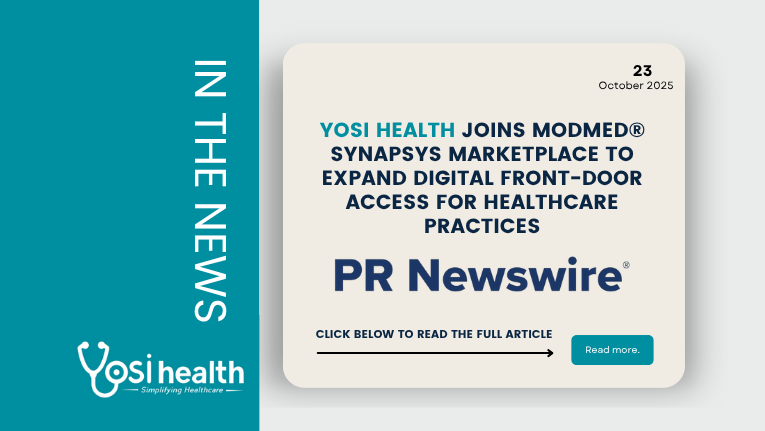
Yosi Health Joins ModMed® synapSYS Marketplace to Expand Digital Front-Door Access for Healthcare Practices
Integration Brings Streamlined Scheduling, Contactless Intake, Real-time Eligibility Checks, and Voice AI Capabilities to ModMed’s Ecosystem
NEW YORK, Oct. 22, 2025 /PRNewswire/ — Yosi Health, a provider of AI-powered digital front door automation solutions, today announced it has joined Modernizing Medicine’s synapSYS Marketplace as a connected digital front-door vendor. The integration enables ModMed® clients to offer patients streamlined online scheduling, pre-visit digital intake, real-time insurance eligibility checks, and AI-powered voice automation – all designed to reduce administrative burden, improve point-of-care readiness, and enhance the patient experience.
Modernizing Medicine’s synapSYS Marketplace connects ModMed’s specialty-focused EHR users with third-party tools that extend functionality across the care continuum. Yosi’s inclusion reflects growing demand from specialty and ambulatory practices for modern, interoperable front-office workflows that minimize duplicated data entry, accelerate check-in, and surface critical patient information before the clinician encounter.
“Joining ModMed’s synapSYS Marketplace is a critical step in making specialty care more efficient and patient-friendly,” said Hari Prasad, CEO of Yosi Health. “When appointment slots, eligibility, and pre-visit intake are verified automatically, clinicians start every visit with cleaner charts, and staff spend less time on repetitive tasks. Our voice AI capabilities also add an always-on layer for routine scheduling and triage, which reduces hold times and ensures urgent calls are routed appropriately, without replacing the human touch.”
ModMed clients can explore Yosi Health’s full capabilities and integration details on the synapSYS Marketplace at https://synapsys.modmed.com/s/partner-app/a9YVV000000080n2AA/yosi-health.
Yosi’s platform captures insurance and demographic data through secure, HIPAA-compliant workflows, performs instant eligibility and benefits checks, and autofills intake forms – ensuring patients complete required documentation ahead of their visit. Yosi’s deterministic voice AI interprets caller intent, books confirmed slots directly from ModMed scheduling availability, recognizes red-flag language for urgent triage, and hands off complex or ambiguous calls to live staff – all with full audit trails for safety and compliance.
Early adopters in other EHR ecosystems have reported measurable operational improvements after deploying comprehensive front-office automation, including reductions in no-shows, decreased phone volumes, faster patient throughput, and improved point-of-service collections. By integrating directly with ModMed via synapSYS, Yosi ensures that data captured at intake – from medication lists to allergy flags and payment preferences – flows into the patient chart and back into clinic workflows in real time. These efficiencies allow clinical staff to focus on patient care rather than administrative tasks, while giving patients a more modern, convenient access experience.
The synapSYS listing also gives ModMed clients a vetted, secure path to adopt front-office automation without lengthy custom integrations. Yosi meets industry security standards, including SOC 2 Type II and PCI compliance, and supports bi-directional integration patterns to preserve data integrity across care settings.
For more information about the Yosi Health Patient Management platform, visit: https://www.yosi.health.
About Yosi Health
Yosi Health is the leading patient engagement and workflow automation platform for busy clinics and care centers. Pioneering remote patient engagement since 2015, Yosi Health has been successfully reducing the cost of care for healthcare providers while improving patient outcomes.
Our award-winning, customizable, and cloud-based solutions are powering medical practices across all 50 States and is bi-directionally integrated with leading Electronic Medical Record (EMR) vendors in the US.
Yosi Health meets the highest patient privacy standards, including HIPAA by being certified as SOC 2 Type 2 Security and PCI compliant in addition to being singled out as an ISV Advanced Technology Partner for Amazon Web Services (AWS); a highly selective program with stringent security requirements for induction.
Yosi Health has been recognized by its clients as the Best in KLAS® 2024 Patient Intake Management vendor. Yosi has also earned the coveted Peer Reviewed™ recognition from the American Alliance of Orthopedic Executives (AAOE).
Click here to Read the full article here.


